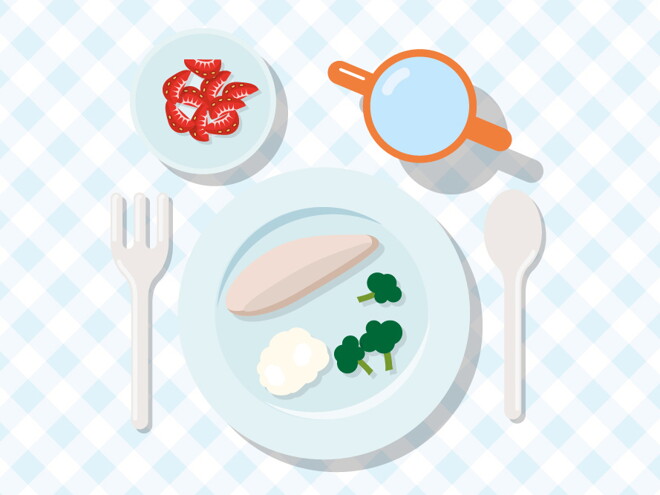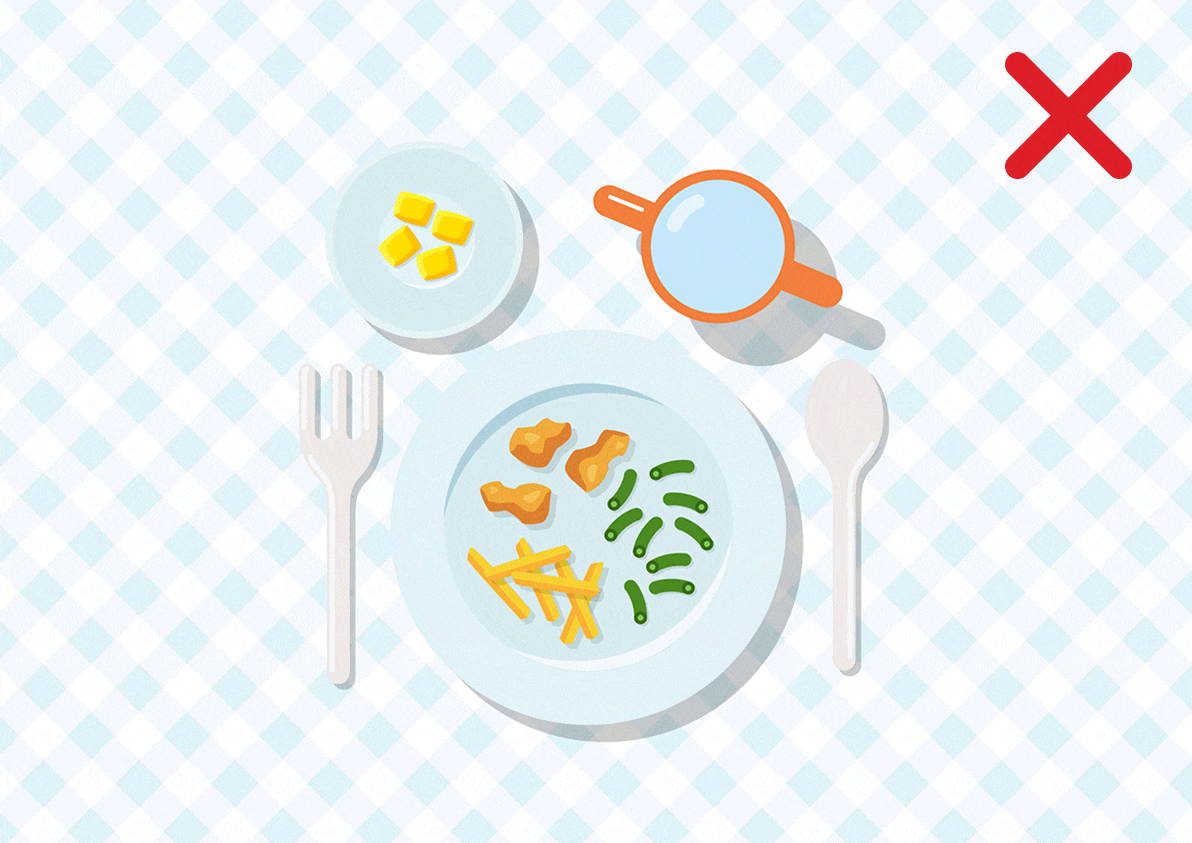
How to avoid mealtime mistakes
Can you spot what’s missing—or what’s not needed—from the following eight table settings? From inappropriate portion sizes and drinks to missing food groups and unhealthy choices, there’s something that can be improved with each of these pictures.

Mealtime mistake 1: Offering fizzy drinks
Sugar-sweetened beverages shouldn’t be part of a toddler’s diet. The empty calories in sugary drinks such as cola or lemonade have no place in your toddler’s healthy diet. They’re also harmful for his emerging teeth, as they can contribute to tooth decay. Offer milk (breast milk, growing-up milk, or cow’s milk) or water with all meals and snacks, and keep a cup of water available for sips throughout the day.

Mealtime mistake 2: Overloading his plate
A serving of bread for a one to two-year-old at one meal is around half a slice. Of course, if your toddler shows you he’s hungry and wants more, you can offer him another half slice. Just don’t overload his plate with too much at the start.

Mealtime mistake 3: Forgetting the veg
Your toddler should have some vegetables with every main meal. This lunch or dinner only includes foods from two of the main food groups: meat from the protein group and rice from the grains group. Add vegetables to this plate and finish off with a serving of fruit and some dairy, and you’ll have checked off all five food groups in one sitting!

Mealtime mistake 4: Thinking he can eat like an adult
Whole carrots and whole grapes are potential choking hazards and should be cut up. This snack, or mini meal, is a healthy choice, but the whole grapes and carrot are a choking risk for toddlers. Grapes should always be cut in half lengthwise, and soft, cooked carrot should be cut into bite-sized pieces.

Mistake 5: Supersizing his portions
A whole chicken breast is too much for a toddler. Toddler portions are much smaller than adult-size servings, and a whole chicken breast is too much for one meal. Around 30g (1oz) of meat or meat alternatives is a more realistic portion for a main meal. As a rough guide, a piece of meat the size of your palm is about 90g (3oz), so aim for about a third of that to first offer your toddler. If he is showing signs of hunger, or asks for more, then follow with another portion.

Mistake 6: Starting the day with sugar
Breakfast cereals high in sugar are an unhealthy choice for toddlers. Your toddler doesn’t need sugar in his diet, so watch out for foods and drinks with high levels of added sugar. Check the label of breakfast cereals before you buy. Avoid those that have 6g or more per 30g of dry cereal. Oatmeal or infant cereals, which are wholegrain and unsweetened, are healthier choices.

Mistake 7: Missing the protein
Guidelines for toddlers suggest including a serving of food from the protein group as part of lunch and dinner meals. This can be meat, but it doesn’t have to be. Cooked dry beans are a good non-meat source of protein.

Mistake 8: Choosing ‘bad’ fats
Deep-fried, high-fat chicken nuggets and fries are unhealthy choices. Foods deep-fried in trans or saturated fats are not good for your toddler. They might also have added salt, sugar, and other flavorings too. Cook your own potato wedges and cut up some cooked, lean chicken for a far healthier, more nutritious alternative. It’s fine to serve your toddler green beans, as long as they are cut up into small, bite-sized pieces.
What does your toddler’s plate look like?
Recognise any of these eight bad habits? Make a note of the simple swaps and try to bring them into your daily mealtime routine. Your toddler’s health will thank you for it in the long run!
Never make these mealtime mistakes? Congratulations! Keep up the good work and be careful not to fall into any bad habits in the future.
Sources
Ramsay SA, Branen LJ, Johnson SL. How much is enough? Tablespoon per year of age approach meets nutrient needs for children. Appetite 2012; 58(1):163-7.
United States Department of Agriculture Food and Nutrition Service. 2016 Child and Adult Care Food Program: Meal Pattern Revisions Related to the Healthy, Hunger-Free Kids Act of 2010. http://federalregister.gov/a/2016-09412
USDA Meal pattern infographic
https://fns-prod.azureedge.net/sites/default/files/tn/cacfp-servetasty1… (Accessed December 5 2018)